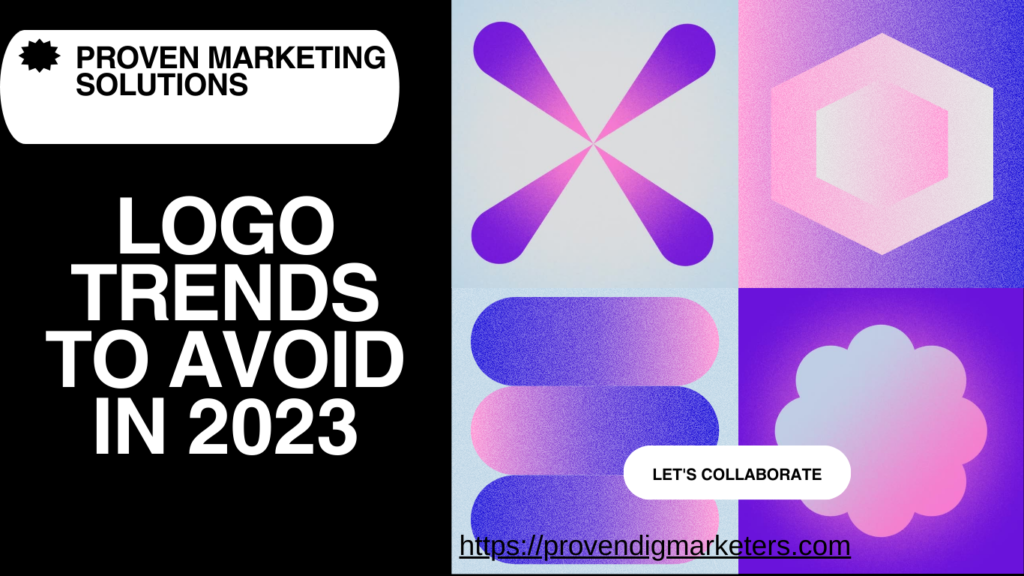In this article we will explore the logo design trend to avoid in 2023 The art of design is a dynamic aspect of our society where trends are customary. Some designs gain the status of classics and, on the other hand, many just fade away and disappear from the public’s awareness.
This means that to maintain a perfect logo for your brand you should avoid some of the trends that are obsolete or cliché.
Before diving into that, let’s take a closer view of what a logo is and why it is important for businesses.

What is a Logo?
A logo is a picture, word, letter, symbol, shape, or other graphic image that is recognized to represent a business, institution, or product.
It plays the role of an identifier and works towards making a brand unique from others to make a lasting impression.
Importance of a Logo to Businesses
A well-designed logo offers numerous benefits for businesses, including:
- Brand Recognition:
This means that the customers are in a position to easily identify your brand and differentiate it from that of other competitors.
- Brand Identity:
A logo is an embodiment of your brand’s character, beliefs, and promise.
- Trust and Credibility:
Good and focused logo design plays a great role in the successful branding of a business and makes people trust it.
- Marketing and Promotion:
A logo is quite versatile and makes it easy to correspond with different marketing aspects ranging from business cards, websites, and social media to even advertising.
- Customer Loyalty:
A good logo serves to make customers loyal by enabling their minds to be accustomed to the brand backcloth.
Hence logos play a crucial role in brand recognition by making brands a unique identity.
Logo Design Trends to Avoid in 2024
Now that we understand the importance of logos, let’s take a closer look at the logo design tendencies that are better to avoid in 2024.
1. Overly Complex Designs
The Problem:
Concerning the weaknesses, the thinking of logos with too many details can be hard to replicate on different platforms and identification at different sizes. They may also be easily forgettable and difficult for the viewers to differentiate and easily identify your brand.
Alternatives:
Go for the plain and simple message. The general information however suggests that a good logo can still be easily identified and easily memorable even in its small dimensions.
Opinion :
Use such elements as clean lines, negative space, and iconic symbols.
An example of this is shown above where there is an example of an artistic logo design that is way too complex for the company’s brand.
2. Gradient Overload
The Problem:
Gradients like all the other classic elements of design are appealing especially when applied sparingly but they can get out of hand. It would be wrong to say that they cannot seem to be very stylish or well put together.
Alternatives:
Choose plain colours and gradients or high contrast or simply choose good patterns that make the logo look modern.
3. Generic Typography
The Problem:
Choosing common and simple fonts like sans-serif is not attractive and therefore can make your logos easily forgotten. The typeface used also has to stem from your brand personality and the ethos of the company.
Alternatives:
A recommendation would be serif fonts, script fonts or custom fonts with the view of developing an enduring logo.
4. Excessive Animated Logo Design
The Issue:
It is possible to make a logo look more interesting when using animations; however, if overdone the animation will be undesirable. They can also make your logo difficult to reproduce, especially in static media and print advertisements.
Alternatives:
Animation can be quite helpful but it should only be applied selectively and in a way that would fit your brand’s image and persona. Think about guided animations that make the logo design look more spectacular without overloading the branding item.
5. Over-Reliance on Trends
The Problem:
Going around in circles in search of what is fashionable may result in the creation of a logo that is already outdated when it is worked on. The emphasis should be put on drawing as universal design as possible predicated on the values that define the brand.
Alternatives:
Always consider design cues that would go down well in front of your audience so that they appeal to them. A suggestion is to also use concepts from design principles that have been going around for some time now.
6. Unclear Messaging
The Problem:
A logo should be able to convey your brand message and this thus requires visibility. Garish and unclear logos therefore tend to disorient the changes of viewers or do not capture the attention of the viewers as required.
Alternatives:
Involve a designer in the formulation of a logo that is aesthetically appealing and carries relevant meaning. It may also draw the use of some symbols, colours and typography that would appeal to the targeted clients.
7. Poor Colour Combinations
The Issue:
When selecting the colours to be used in the logo, it is important not to choose relative colours or contrast colours as this will make your logo look unprofessional and unattractive. You should also have colours that are harmonious and that have an accurate portrayal of the personality of your brand.
Alternatives:
Utilise the aspects of colour theory and practice which will help in choosing the correct colour scheme that will enhance the overall aesthetic value of a page. It is also advisable to try to find complementary analogous colours by using the colour wheel.
8. Overly Trendy Symbols
The Problem:
Do not use symbols that trend as this will make the logo adapted to that trend and hence become outdated. When selecting the symbols, certain themes have to be adhered to so that they reflect the intended message of the brand.
Alternatives:
When choosing symbols, one should stick with the history, cultural, or natural associations. It is also possible to create new symbols which are exclusive to your brand.
9. Lack of Scalability
The Problem:
It is not ideal if a logo cannot be readily duplicated in different sizes and outputs or resolutions. On using them on a small screen or in low-resolution images they often look pixelated and blurry.
Alternatives:
Make sure that you give equal importance to your logo design when it comes to scalability. Vector graphics should be used to design a logo because it can easily and seamlessly be scaled to different sizes.
10. Ignoring Target Audience
The Problem:
A logo that is not going to be acceptable to your target demographic is not going to be too effective either. Preferably, you should take into consideration the perception and the expectation of your audience to your logos.
Alternatives:
Get to know your customers including their preferences and beliefs. You should develop a logo which will be somehow appealing to them and conform to the overall image of your company or organisation.
In essence, it is advised to avoid the logo design trends identified above in order to come up with an awesome brand that will be effective for many years to come. For logo design, you must hire an expert graphics designer or agency like proven digital marketers, who can put your idea into soul. Remember, a well-designed logo is an investment that can pay off.


